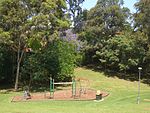The Division of Bennelong is an Australian electoral division in the state of New South Wales. The division was created in 1949 and is named after Woollarawarre Bennelong, an Aboriginal man befriended by the first Governor of New South Wales, Arthur Phillip. The seat is represented by Jerome Laxale since the 2022 Australian federal election
Bennelong covers 60 km2 of the Northern Sydney region, including all of the local government areas of Ryde and parts of Hornsby and Parramatta. It includes the suburbs of Denistone, Denistone East, Denistone West, East Ryde, Eastwood, Epping, Macquarie Park, Marsfield, Meadowbank, Melrose Park, North Epping, North Ryde, Putney, Ryde, Tennyson Point and West Ryde; as well as parts of Beecroft, Carlingford, Chatswood West, Dundas, Ermington and Gladesville.
It was represented from 1974 until 2007 by John Howard, who served as the Prime Minister of Australia from 1996 until 2007. As well as his government then being defeated, Howard also became the second sitting Australian Prime Minister to lose his own seat. Though historically a fairly safe Liberal seat, modern-day electoral boundaries and demographic changes have seen Bennelong become an increasingly marginal seat. The 2007 outcome in Bennelong resulted in Labor candidate Maxine McKew winning the seat on a thin 1.4 percent margin after a close contest, making her the first Labor MP for Bennelong. After a single term, McKew was defeated by Liberal candidate John Alexander in 2010, who retained it (not including a short vacancy in 2017) until the 2022 general election.
The seat was vacant from 11 November 2017 when Alexander resigned amid the 2017–18 Australian parliamentary eligibility crisis after confirming he was a dual citizen and therefore ineligible to sit in parliament. Despite a significant swing against him, Alexander was re-elected at the 2017 Bennelong by-election on 16 December.










